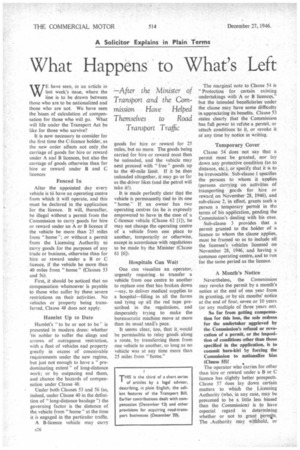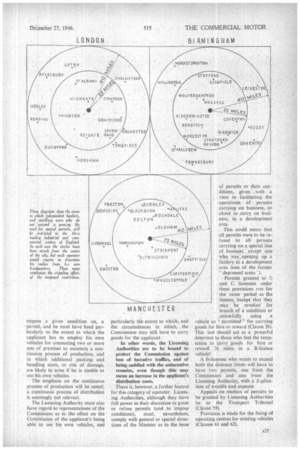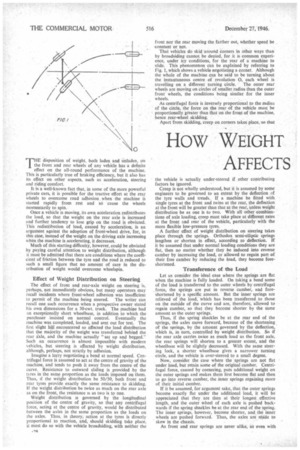A Solicitor Explains in Plain Terms
Page 28

Page 29

Page 30

If you've noticed an error in this article please click here to report it so we can fix it.
What Happens to What's Left
—After the Minister of Transport and the Commission Have Helped Themselves to Road Transport Traffic
WE have seen, in an article in last week's issue, where the line is to be drawn between those who are to be nationalized and those who are not. We have seen the bases of calculation of compensation for those who will go. What will life under the Transport Act be like for those who survive?
It is now necessary to consider lot the first time the C-licence holder, as the new order affects not only the carriage of goods for hire or reward tinder A and B licences, but also the carriage of goods otherwise than for hire or reward under B and C licences
Fenced In
After the appointed day every vehicle is to have an operating centre from which it will operate, and this must be declared in the application for the licence. It will, thereafter, be illegal without a permit from the Commission to carry goods for hire or reward under an A or B licence if the vehicle be more than 25 miles from " home "; or without a permit from the Licensing Authority to carry goods for the purposes of any trade or business, otherwise than for hire or reward under a B or C licence, if the vehicle be more than 40 miles from " home " (Clauses 53 and 56).
First, it should be noticed that no compensation whatsoever is payable to those who suffer by these severe restrictions on their activities. No vehicles or property being transferred, Clause 48 does not apply.
Hamlet Up to Date Hamlet's "to be or not to be" is presented in modern dress: whether 'Us nobler to suffer the slings and arrows of outrageous restriction. with a fleet of vehicles and property greatly in excess of conceivable requirements under the new regime, but just not enough to have a "predominating extent" of long-distance work; or by outpacing end them, and chance the hazards of compensation under Clause 48.
Under both Clauses 53 and 56 (as, indeed, under Clause 40 in the definition of long-distance haulage ") the governing factor is the distance of the vehicle from " home " at the time it is engaged in the particular traffic.
A B-licence vehicle may carry goods for hire or reward for 25 miles, but no more. The goods being carried for hire or reward must then he unloaded, and the vehicle may next proceed with " free " goods up to the 40-mile limit. If it be then unloaded altogether, it may go as far as the driver likes (and the petrol will take it!).
It is made perfectly clear that the vehicle is permanently tied to its one "home." If an owner has two operating centres (as he is expressly empowered to have in the case of a C-licence vehicle (Clause 62 PA he may not change the operating centre of a vehicle from one place to another, temporarily or otherwise, except in accordance with regulations to be made by the Minister (Clause 61 [6]).
Hospitals Can Wait One can visualize an operator, urgently requiring to transfer a vehicle from one centre to another to replace one that has broken down —say, to deliver medical supplies to a hospital—filling in all the forms and tying up all the red tape prescribed in the regulations, and desperately trying to make the bureaucratic machine move at more than its usual snail's pace.
It seems clear, too, that it would be permissible to relay goods along a route, by transferring them from One vehicle to another, so long as no vehicle was at any time more than 25 miles from "home." The marginal note to Clause 54 is "Protection for certain • existing undertakings with A or B licences," but the intended beneficiaries under the clause may have some difficulty in appreciating its benefits. Clause 53 states clearly that the Commission has full power to refuse a permit, or attach conditions to it, or revoke it at any time by notice in writing.
Temporary Cover
Clause 54 does not say that a permit must be granted, nor lay down any protective condition (as to distance, etc.), or specify that it is to be irrevocable. Sub-clause 1 specifies the persons to whom it applies (persons carrying on activities of transporting gocds for hire or reward on November 28, 1946), and sub-clause 2, in effect, grants such a person a temporary permit in ttv..terms of his application, pending the Commission's dealing with his case_ Sub-clause 3 provides that a permit granted to the holder of a licence to whom the clause applies, must be framed so as to include all the licensee's vehicles licensed on November 28, 1946, and having a common operating centre, and to tun for the same period as the licence.
A Month's Notice
Nevertheless, the Commission may revoke the permit by a month's notice at the end of one year from its granting, or by six months' notice at the end of four, seven or 10 years (or any multiple of three years on).
So far from getting compensation for this loss, the sole redress for the undertaker aggrieved by the Commission's refusal or revocation of a permit, or the imposition of conditions other than those specified in the application, is to commit hara-kiri by forcing the Commission to nationalize him (Clause 55)! • The operator who carries for other than hire or reward under a B or C licence has slightly better prospects. Clause 57 does lay down certain matters to which the Licensing Authority (who, in any case, may be presumed to be a little less biased than the Commission) is to have especial regard in determining whether or not to grant permits. The Authority may withhold, or impose a given condition on, a
• permit, and he must have heed particularly to the extent to which the applicant has to employ his own vehicles for connecting two or more sets of premises to maintain a Continuous process of production, and in which additional packing and handling costs, or risk of damage, are likely to arise if he is unable to use his own vehicles.
The emphasis on the continuous process of production will be noted; a continuous process of distribution is seemingly not relevant.
The Licensing Authority must also have regard to representations of the Commission as to the effect on the Commission of the applicant's being able to use his own vehicles,. and particularly the extent to which, and the circumstances in which, the Commission may still have to carry goods for the applicant In other words, the Licensing Authorities are to be bound to protect the Commission against loss of lucrative traffics, and of being saddled with the uniticrative remains, even though this may mean an increase in the applicant's distribution costs.
There is, however, a further hazard for this category-of operator. Licensing Authorities, although they have full power in their discretion to grant or refuse permits (and to impose conditions), must, nevertheless, comply with general or special directions of the Minister as to the issue
of permits or their conditions, given with a view to facilitating the operations of persons carrying on business, or about to .carry on business, in a development area.
This could mean that all permits were to be refused to all persons carrying on a.special line of business,. except one who was , opening up a factory in a development area (one of the former " depressed areas ).
Permits granted to F..3 and C licensees tinder these provisions run for ' the same period as the Licence, except that t hey may • be revoked for . breach of a condition or
unlawfully using a vehicle so permitted" for carrying goods for hire or reward (Clause 58). This last should act as a powerful deterrent to those who feel the temptation to carry. 'goods for hire or reward 26 . miles in a 13-licence. vehicle!
A B-licensee who wants to exceed both the distance limits will have to have two permits, one from the Commission and one from the Licensing Authority, with a d splica tion of trouble and ,expense . Appeals on matters of permits to he granted by Licensing Authorities lie to the Transport Tribunal (Clause 59).
Provision is made for the fixing of operating centres for existing vehicles (Clauses 61 and 62). front nor the rear moving the farther out, whether speed be constant or not.
That vehicles do skid around corners in other ways than by broadsiding cannot be denied, for it is common experience, under icy conditions, for the rear of a machine to slide. This phenomenon can be explained by referring to Fig. 1, which shows a vehicle negotiating a corner. Although the whole of the machine can be said to be turning about the instantaneous centre of revolution 0, each wheel is
travelling on a different turning circle. The outer rear wheels are moving on circles of smaller radius than the outer front wheels, the conditions being similar for the inner wheels.
As centrifugal force is inversely proportional to the radius of the circle, the force on the rear of the .vehicle must be proportionally greater than that on the front of the machine, hence rear-wheel skidding.
Apart from skidding, creep on corners takes place, so that




































































